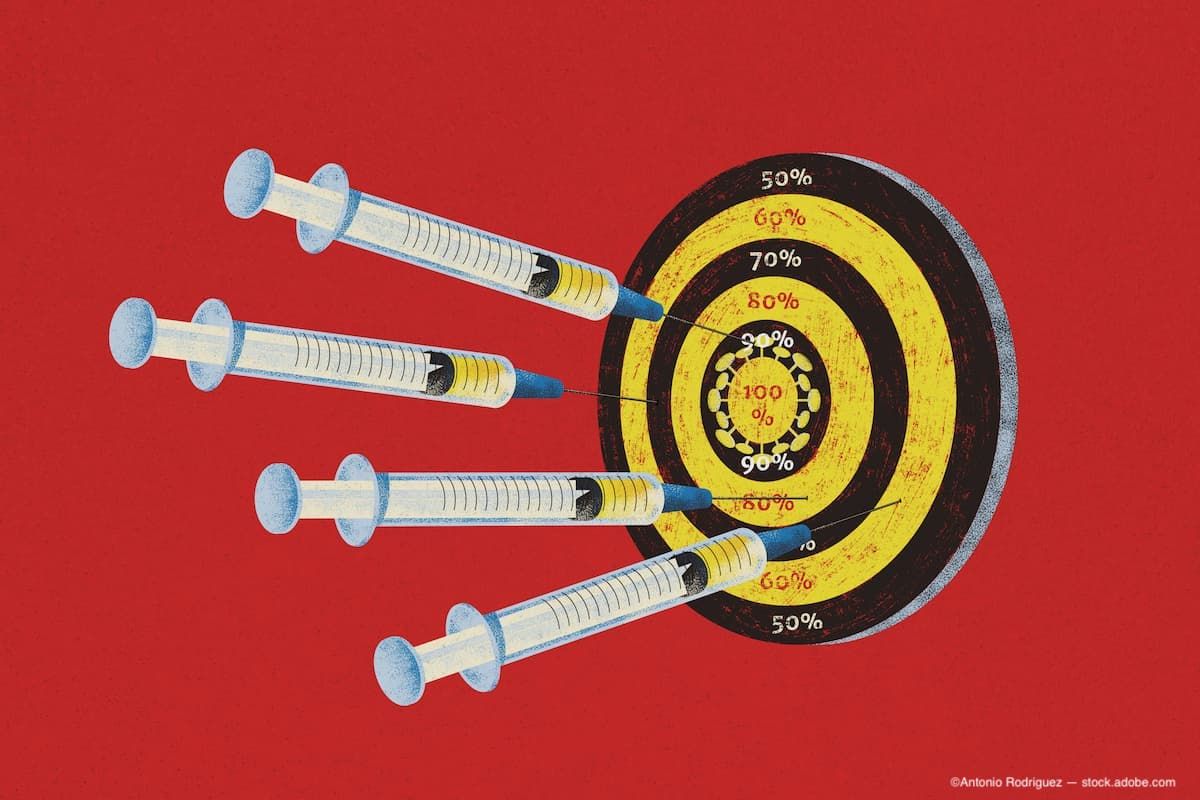Publication
Article
Digital Edition
Comparing the efficacy of pegcetacoplan and avacincaptad pegol in patients with GA
Author(s):
Anchored matching-adjusted indirect comparison may aid decision-making
(Image Credit: AdobeStock/Antonio Rodriguez)

reviewed by Paul Hahn, MD, PhD
A study that indirectly compared the efficacy of 2 drugs evaluated in phase 3 trials using an anchored matching-adjusted indirect comparison found that pegcetacoplan injection (Syfovre, Apellis Pharmaceuticals) exhibited a better efficacy profile than avacincaptad pegol (Izervay, Iveric Bio) among patients with nonsubfoveal geographic atrophy (GA).
Paul Hahn, MD, PhD, of NJRetina, in Teaneck, New Jersey, described how this conclusion was reached at the 2023 American Society of Retina Specialists 41st Annual Meeting in Seattle, Washington this summer.
Ophthalmologists now have these 2 complement inhibitors for GA: Pegcetacoplan was the first of the 2 approved for GA in February 2023, followed by avacincaptad pegol 6 months later.
Both treatments target complement proteins but do so through different mechanisms, Hahn explained. Pegcetacoplan works slightly further upstream, targeting C3 and C3b, and avacincaptad pegol targets C5.
The challenge now is for clinicians to determine which treatment to use, he pointed out.
Independent studies have shown that both therapies slowed the growth of GA in pivotal phase 3 trials. The OAKS (NCT03525613) and DERBY (NCT03525600) trials evaluated the effect of pegcetacoplan on nonsubfoveal and subfoveal GA lesions using monthly and every-other-month dosing, and the GATHER2 trial (NCT04435366) looked at the effect of avacincaptad pegol on nonsubfoveal GA lesions treated monthly. The data in the OAKS and DERBY trials, which covered a longer term, showed that pegcetacoplan slowed the progression of GA.
A problem for clinicians is that the efficacy data obtained by the 2 drugs cannot be compared head-to-head because of the different study designs. Hahn commented, “The combined OAKS and DERBY results showed reduced GA growth in only the nonsubfoveal lesions at 12 months. That was similar to that seen in the avacincaptad pegol study. Looking at the top-line data, it may be tempting to compare the raw numbers between the pegcetacoplan and avacincaptad pegol studies to get a sense of the relative efficacies. However, this is not the correct approach. It is dangerous and frankly wrong to compare top-line data.”
Anchored matching-adjusted indirect comparison
He suggested that a better way to compare the data from the 2 drugs might be the anchored matching-adjusted indirect comparison. “This is a well-validated methodology used in multiple therapeutic areas and sometimes required by regulatory agencies for approval. In the absence of a head-to-head study, this approach tries to compare the relative efficacies of the findings from 2 different studies of 2 different agents, in this case, the effects of pegcetacoplan and avacincaptad pegol in patients with nonsubfoveal GA secondary to macular degeneration,” Hahn said.
Using this approach, he explained, the first step is the application of the inclusion-to-exclusion criteria from the more restrictive trial to the less restrictive trial to match those inclusion-to-exclusion criteria as best as possible. In this case, the inclusion-to-exclusion criteria from the GATHER2 trial were applied to individual patient-level data from the OAKS and DERBY trials to select a similar group of patients, including only those with nonsubfoveal GA and excluding those with choroidal neovascularization in the fellow eye, including a specific range of vision as specified in the GATHER2 study.
Once that has been accomplished, the next step is using propensity score weighting to balance the key baseline characteristics, which were selected a priori between the 2 trials. Those included age, vision, intraocular pressure, and GA characteristics such as size, laterality, and focality.
After this methodology was applied, the sample size decreased from about 310 patients with nonsubfoveal lesions treated with pegcetacoplan in the OAKS and DERBY trials to about 220 patients after filtering out and matching those criteria. The different findings in the trials then can be compared, ie, OAKS vs GATHER2 and DERBY vs GATHER2, all anchored to a sham arm.
He clarified that when comparing pegcetacoplan monthly to avacincaptad pegol monthly, a look at the top-line data comparing the OAKS and GATHER2 results shows a 37% greater reduction with pegcetacoplan monthly compared with avacincaptad pegol monthly, which reached significance.
The comparison of the DERBY and GATHER2 results showed a 12% greater reduction favoring pegcetacoplan monthly, a difference that did not reach significance.
However, when both the OAKS and DERBY results were compared to the GATHER2 results, a 30% greater reduction was seen that favored pegcetacoplan monthly, which was significant.
When the data from the pegcetacoplan every-other-month arm was compared with more frequent dosing with avacincaptad pegol monthly, the numerical results favored pegcetacoplan every-other-month dosing, but the difference was not significant.
Considerations
Hahn also offered the caveat that there are limitations to this type of analysis. “This is a post hoc analysis of clinical trials, and as such, the generalizability to the population and the conclusions need to be interpreted with caution. As a feature of this type of analysis, individual patient-level data were only available for the OAKS and DERBY trials and not for the GATHER2 trial, and we, therefore, had to limit our baseline matching to characteristics that were reported or published for GATHER2,” he said.
In addition, other differences may exist in nonobserved characteristics, such as in the study design and enrollment criteria. “The effective sample sizes are reduced by this analysis, but through this analysis, we suggest that pegcetacoplan may have a better efficacy profile than avacincaptad pegol among patients with nonsubfoveal GA. Specifically, if we look at pegcetacoplan monthly, we saw a significant reduction exceeding 30% in GA lesion growth at month 12 for the combined analysis of the OAKS and DERBY studies compared with avacincaptad pegol at the same monthly frequency. One step further, there was no difference in efficacy between every-other-month pegcetacoplan dosing and monthly avacincaptad pegol dosing,” he commented.
He advised that since the FDA has approved 2 drugs to manage GA, clinicians now have the task of figuring out which of these drugs to use. “This analysis provides one piece of the data, and each of us will have to make our own decision as we start to incorporate these drugs into our armamentarium,” Hahn concluded.
Paul Hahn, MD, PhD
E: phahn@njretina.com
Hahn is in private practice in Teaneck, New Jersey. He is also on the advisory board of and is a consultant to Apellis Pharmaceuticals.
Reference
1. Pegcetacoplan vs avacincaptad pegol in patients with geographic atrophy. Modern Retina™. September 8, 2023. Accessed October 20, 2023. https://www.modernretina.com/view/pegcetacoplan-vs-avacincaptad-pegol-in-patients-with-geographic-atrophy






